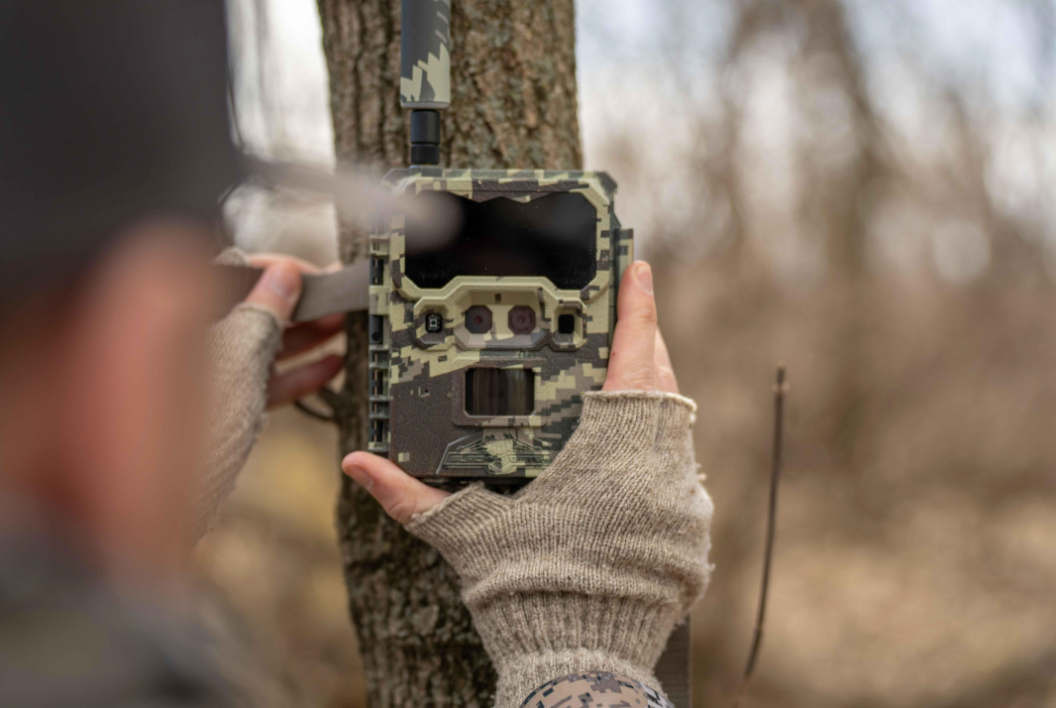Hunting mature bucks in the big woods is one of the toughest—but most rewarding—challenges in whitetail hunting. In vast expanses of hardwoods, clear cuts, and rugged terrain, deer aren’t easy to pattern. There are no fence lines, no agricultural field edges, and often no consistent food sources.
But one thing can tip the odds in your favor: a strategically placed trail camera.
During the rut, big woods bucks cover serious ground looking for does. And while they’re harder to pin down, they still leave clues—rubs, scrapes, tracks, and movement corridors. With the right trail camera tips for big woods bucks, you can turn miles of forest into actionable scouting data that leads to success.
1. Focus on Funnels, Not Fields
In thick, expansive woods, you won’t find obvious food plot edges or fence rows. Instead, look for terrain-based funnels—natural features that pinch movement.
Examples:
- Saddle points between two ridges
- Bench trails on the downwind side of hills
- Creek crossings or erosion ditches
- Logging road intersections
Mature bucks cruising for does during the rut often use these paths of least resistance. Setting up a trail camera in one of these areas helps you monitor the natural “highways” that connect bedding to breeding zones.
Pro Tip: Use topo maps and satellite imagery to scout these areas before ever stepping into the woods.
2. Go Deep to Find Daylight Movement
Big woods deer, especially mature bucks, don’t tolerate pressure. That means you’ll need to get away from parking areas, ATV trails, and human scent corridors to find daylight rut movement.
Trail Camera Setup Tips:
- Hike in at least ¾ mile from roads
- Place cameras near remote bedding ridges or overlooked benches
- Hang cams at higher-than-eye-level (6–7 ft) to avoid detection from both deer and other hunters
The Black Gate R4G LITE+ is lightweight and packable with the fold down antenna—ideal for backcountry camera sets that need to stay hidden, quiet, and efficient all season.
3. Monitor Doe Groups, Not Just Buck Sign
Big woods bucks often show up where the does already are. Find doe family groups, and you’ll be in the game when the rut kicks in.
Key Signs to Watch:
- Regular trail activity from does
- Fresh droppings or beds in laurel thickets or swamp edges
- Multiple scrape and rub clusters nearby
Set up trail cameras downwind of these locations during late October and into November. Bucks will start checking does during legal shooting light—and your camera can confirm when it’s time to move in.
4. Use Video Mode to Capture Behavior
In the big woods, you often get just one chance. Understanding what bucks are doing when they pass your camera can tell you whether they’re just cruising—or hot on the trail of a doe.
Video Mode Tips:
- Record 10 second clips
- Use medium sensitivity to avoid false triggers
- Mount cameras with a wide field of view to capture full sequences
The R4G GEN2 shoots HD video and transmits files via cellular connection, giving you a full look at rut behavior in real time—without spooking deer.
5. Don’t Rely on Scrapes Alone
Yes, scrapes are a great starting point—but during the rut, bucks often abandon scrapes as they start to seek and chase.
If you’re still getting nighttime scrape activity and no daylight photos, shift your focus:
- Track fresh tracks on trails leading away from scrapes
- Set up on downwind sides of suspected bedding
- Monitor terrain funnels that connect multiple doe bedding zones
Your trail cameras should follow the action. Use your early scrape-line photos to estimate buck presence, then redeploy to intercept zones.
6. Cellular Trail Cameras = Less Pressure
In big woods hunting, minimizing intrusion is critical. You don’t want to be hiking in every few days to check your SD cards—especially in bedding areas or remote travel routes.
Why Go Cellular:
- Monitor scrapes, ridges, or funnels without leaving scent
- Track real-time rut behavior and movement shifts
- Adjust stand location or timing based on live data
The R4G GEN2 delivers crystal-clear images and videos directly to your phone, making it one of the best cellular trail cameras for big woods bucks.
7. Be Mobile and Think Like a Deer
Mature bucks in vast timber country don't stay put. They roam long distances during the rut—especially where hunting pressure is low. Your trail cameras should reflect that.
Mobility Strategy:
- Hang cameras temporarily and move based on fresh sign
- Focus on travel patterns, not just one “perfect” stand
- Use trail cam intel to leapfrog ahead of cruising bucks
Consider using multiple lightweight trail cams like the R4G LITE+ to build a web of intel across ridge systems and thermal hubs.
Final Thoughts
Hunting big woods bucks is a thinking man’s game—and your trail camera is your most reliable scout. When you use it to monitor terrain funnels, bedding transitions, and doe hotspots, you start to connect the dots on mature buck movement during the rut.
With dependable gear like the R4G GEN2 and R4G LITE+, Black Gate helps hunters go deeper, scout smarter, and make every move count—especially when the woods get wild.
🎯 Ready to upgrade your big woods strategy? Shop Black Gate Trail Cameras Now




Share:
Late Summer Trail Camera Strategies for Early Season Deer Scouting
Trail Camera Setup for Food Plot Hunting: Best Angles, Timing, and Locations